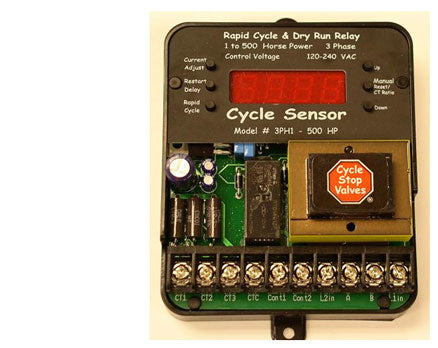Dry Well Protection

When using a pump in a low yield well, it is advisable to use some sort of dry well protection. A low pressure cut-off feature on the pressure switch will work most of the time. However, if the well was almost depleted just as the last faucet or tap is closed the well could be pumped dry while trying to refill the pressure tank. In this case the pressure will not drop, as no water is being used. The pump will suck air, loose prime, and melt down, because the low pressure cut-off switch does not see low pressure and shut off power to the motor. When a low pressure cut-off switch does shut the pump down on low pressure, the switch must be manually reset before the pump will restart.
Other Dry Well protection devices like the Cycle Sensor look for low amperage instead of low pressure. The amperage drawn by the motor is always lower when air is in the pump instead of water. These devices will shut off power to the pump motor when the pump draws in air, regardless of the pressure in the pressure tank. These devices also have a restart timer. They will automatically restart the pump after the well has had a certain amount of time to recover.
When the well is a low producer, and also has very little stored water in the well, a storage tank and booster pump may be needed. A storage tank usually has a float switch that turns off the well pump when the storage tank is full. The well pump is turned on again when the water level in the storage tank drops a few inches, and the float switch drops. The well pump can be supplied with a flow restricting device such as a Dole valve. A Dole valve is sized to prevent the well pump from producing more flow than the well can yield. If the well yield is only 1 or 3 GPM, then a 1 or 3 GPM Dole valve is used, and the storage tank is filled at 1 or 3 GPM. Most well pumps can safely produce as little as 1 GPM without overheating. It is still a good idea to use a low amperage dry well protection device for safety.
If a Dole valve is not used, many times the dry well protection device will allow the storage tank to fill until the well is dry. The well pump is then shut off on low amperage, the well recharges for the length of time adjusted on the dry well protection device, and the well pump is again restarted. This process is repeated until the storage tank is full, and the float switch shuts off power to the well pump. It is generally better to restrict the output of the well pump to less than the yield of the well. Repeatedly pumping the well dry and restarting the pump can shorten the life of the well pump. Repeatedly pumping the well dry can also cause problems with the well itself.
Some Dry Well Protection Relays will not work with a Cycle Stop Valve. A CSV causes the amperage to vary according to the amount of water being used. At the lowest amperage created by using the CSV, relays such as the Pumptec, Pump Saver, Coyote, and others incorrectly think the well is dry and turn off your pump system. Setting these devices while using half of the maximum flow may help. In other words, if you have a 10 gpm pump, set the device when you are using 5 gpm. Most of these devices look for a 25% drop in amps and shut the pump off. If the pump you have has good brake horsepower, these devices may not work with the CSV. A good brake horsepower or drop in amps is a good thing. This means lower amps and less electricity used. Some pumps have a better brake in horsepower than others. If the amp drop with your pump is more than 25%, devices such as the Pumptec, Symcom Pump Saver, or Coyote will not work with a Cycle Stop Valve. These devices will turn off your pump even though there is not a dry well problem.
The Cycle Sensor is completely adjustable and will work with a CSV on any pump. The Cycle Sensor can easily be fine tuned to know the difference between a CSV on a pump with a good brake in horsepower, and an actual dry well condition.
